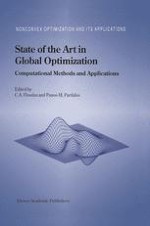Optimization problems abound in most fields of science, engineering, and tech nology. In many of these problems it is necessary to compute the global optimum (or a good approximation) of a multivariable function. The variables that define the function to be optimized can be continuous and/or discrete and, in addition, many times satisfy certain constraints. Global optimization problems belong to the complexity class of NP-hard prob lems. Such problems are very difficult to solve. Traditional descent optimization algorithms based on local information are not adequate for solving these problems. In most cases of practical interest the number of local optima increases, on the aver age, exponentially with the size of the problem (number of variables). Furthermore, most of the traditional approaches fail to escape from a local optimum in order to continue the search for the global solution. Global optimization has received a lot of attention in the past ten years, due to the success of new algorithms for solving large classes of problems from diverse areas such as engineering design and control, computational chemistry and biology, structural optimization, computer science, operations research, and economics. This book contains refereed invited papers presented at the conference on "State of the Art in Global Optimization: Computational Methods and Applications" held at Princeton University, April 28-30, 1995. The conference presented current re search on global optimization and related applications in science and engineering. The papers included in this book cover a wide spectrum of approaches for solving global optimization problems and applications.
